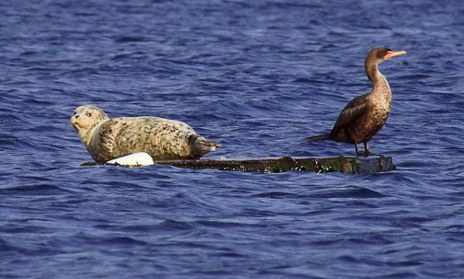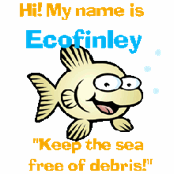Apr 2010
Sight impaired seal finds safe haven on Alki
Apr/30/10 08:32 PM

Tranquil sunrise for resting seals
Apr/26/10 07:51 AM
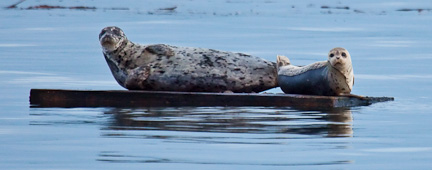
Ballard sea lion necropsy findings
Apr/21/10 12:35 PM
On Tuesday, April 20th, a thorough examination was performed by Washington Department of Fish and Wildlife and Cascadia Research on the adult male California sea lion that stranded live at Golden Gardens on Sunday, April 18th. The preliminary findings are as follows:
Total body radiographs (x-rays) taken at Pt. Defiance Zoo and Aquarium did not reveal any evidence that it had been shot. However, there appeared to be some abnormalities in the chest cavity, confirmed upon necropsy by the finding of a fractured sternum between ribs four and five and a significant amount of hemorraging (bruising) into the surrounding muscle. The fractured sternum was placing pressure on the aorta/heart, causing some of the small arteries around the heart and pericardium to rupture, which resulted in internal bleeding into the chest cavity and the subsequent death of the animal.
A fractured sternum is typically attributed to blunt force trauma and likely was the cause of the sea lion stranding. This would also have contributed to his difficulty moving while on the beach and the abnormal behavior of not returning to the water. There are a number of circumstances which could have caused the blunt force trauma - boat collision or another type of negative human interaction, transient orca attack, a fight with another sea lion, a fall from a rocky resting spot, etc. The external injuries, which were noted on the beach, were determined to be old wounds that had healed.
The thorough examination resulted in the collection of a large number of samples for additional analyses including examination for pathology, microbiology, bioxtoxins, and contaminants. These results will not be known for weeks or months, but may provide additional insights not only into the cause of death but into the overall health of this sea lion.
Total body radiographs (x-rays) taken at Pt. Defiance Zoo and Aquarium did not reveal any evidence that it had been shot. However, there appeared to be some abnormalities in the chest cavity, confirmed upon necropsy by the finding of a fractured sternum between ribs four and five and a significant amount of hemorraging (bruising) into the surrounding muscle. The fractured sternum was placing pressure on the aorta/heart, causing some of the small arteries around the heart and pericardium to rupture, which resulted in internal bleeding into the chest cavity and the subsequent death of the animal.
A fractured sternum is typically attributed to blunt force trauma and likely was the cause of the sea lion stranding. This would also have contributed to his difficulty moving while on the beach and the abnormal behavior of not returning to the water. There are a number of circumstances which could have caused the blunt force trauma - boat collision or another type of negative human interaction, transient orca attack, a fight with another sea lion, a fall from a rocky resting spot, etc. The external injuries, which were noted on the beach, were determined to be old wounds that had healed.
The thorough examination resulted in the collection of a large number of samples for additional analyses including examination for pathology, microbiology, bioxtoxins, and contaminants. These results will not be known for weeks or months, but may provide additional insights not only into the cause of death but into the overall health of this sea lion.
Otis Redding update
Apr/20/10 09:29 PM
(please see end of story for latest info)
Otis Redding, our struggling adult harbor seal, is still hanging out on the boat dock. He is progressively getting thinner, but his infections seem to be improving and there is no longer evidence of parasites in his fecal matter. He is still managing to forage, but seemed a little less alert today. He returned to the water this evening, but we expect to see him again tomorrow. It is a difficult choice to determine whether intervention would help or make matters worse. The stress of capture could reverse the improvements he has made by being able to rest undisturbed on the dock. Be assured he is being closely monitored by SS volunteers and experts who analyze our photos daily (SS cannot thank them enough). Thanks to everyone who uses the boat ramp for being so considerate of Otis’ presence.
(update Apr/24/2010 7:03 am) To our knowledge, Otis has not been on the dock for the last 48 hours (he could have been there off hours, but just not seen). We are hoping this is a sign that his infections have healed to the point where he can fish successfully and that he has chosen a less busy spot to haul out and fatten up. Since adult harbor seals are very shy and tend to avoid people, this would be normal behavior. Of course, he may have become accustomed to the hospitality of West Seattle citizens and return for some more recovery time. If you see a seal on the dock or elsewhere on shore, please call our hotline @ 206-905-7325 (SEAL) so we can continue to monitor the health of our pinnipeds.
Otis Redding, our struggling adult harbor seal, is still hanging out on the boat dock. He is progressively getting thinner, but his infections seem to be improving and there is no longer evidence of parasites in his fecal matter. He is still managing to forage, but seemed a little less alert today. He returned to the water this evening, but we expect to see him again tomorrow. It is a difficult choice to determine whether intervention would help or make matters worse. The stress of capture could reverse the improvements he has made by being able to rest undisturbed on the dock. Be assured he is being closely monitored by SS volunteers and experts who analyze our photos daily (SS cannot thank them enough). Thanks to everyone who uses the boat ramp for being so considerate of Otis’ presence.
(update Apr/24/2010 7:03 am) To our knowledge, Otis has not been on the dock for the last 48 hours (he could have been there off hours, but just not seen). We are hoping this is a sign that his infections have healed to the point where he can fish successfully and that he has chosen a less busy spot to haul out and fatten up. Since adult harbor seals are very shy and tend to avoid people, this would be normal behavior. Of course, he may have become accustomed to the hospitality of West Seattle citizens and return for some more recovery time. If you see a seal on the dock or elsewhere on shore, please call our hotline @ 206-905-7325 (SEAL) so we can continue to monitor the health of our pinnipeds.
Gray whale necropsy reveals trash inside stomach
Apr/20/10 04:32 PM
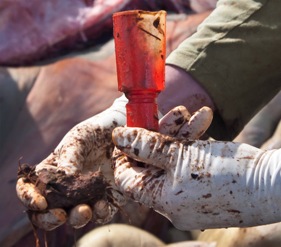
The public should give many thanks to the necropsy team for performing this incredibly important and physically strenuous work. Due to their dedication and efforts, we are now aware of the role that pollution may have played in the death of this whale - as it indeed impacts all our marine life. Plastics that end up in our waters never go away - they eventually end up as micro particles which absorb contaminants and enter the marine food chain, causing deformities and disease. It is well known that our local seals and orcas are laced with pcbs and other toxic chemicals. Depletion of food sources caused by commercial overfishing and pollution can be reversed by getting involved. You CAN make a difference - pick up trash on the beach, don’t purchase seafood on the seafood watch list and ask your grocer not to sell it, help clean up the Sound.
As an observer, our volunteer was stunned at the amount of trash that was removed from the whale - and overwhelmed with sadness that human impact had, in any way, contributed to this whale’s demise. Please learn more about our polluted waters and the Great Pacific Garbage Patch, an oceanic swirling mass of plastic twice the size of Texas, on Seal Sitters’ website. Educate people about the dangers of pollution and its tragic impact on our wildlife now and for generations to come. Make a commitment that this magnificent whale’s life was not given in vain.
See news video here.
Read Lynda Mape’s excellent article in the Seattle Times.
New logo design by Uko Gorter
Apr/20/10 07:54 AM

Uko is president of the Puget Sound Chapter of the American Cetacean Society (the group recently featured a presentation by SS) and a leading scientific and natural history illustrator, specializing in marine mammal illustration. Visit Uko’s website.
Sea lion dies overnight
Apr/20/10 07:41 AM
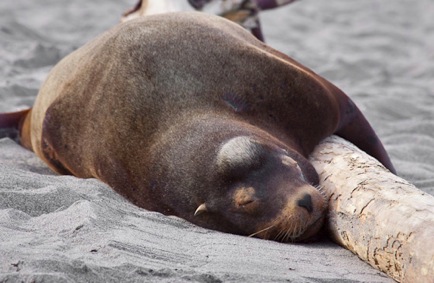
Thanks to the team that worked so valiantly to help him. And thanks to the many onlookers in Ballard who showed such concern and kindness towards this gentle old “seadog”.
RELATED NEWS LINKS
Injured sea lion found on Seattle beach dies (KING 5)
Sea lion dies after rescue effort at Golden Gardens (Seattle Times)
“Golden” the sea lion dies (MyNorthwest.com - KIRO news radio website)
Sea lion rescued in Ballard
Apr/19/10 07:50 PM

A Seal Sitter volunteer responded early this morning to find the thin and listless sea lion resting between two logs on the beach. A perimeter was established with Protected Marine Mammal tape. Thankfully, at that time the beach was uncrowded and health assessment photos were taken and emailed to NOAA and WDFW for evaluation. Reports of wounds on the animal appear to be older wounds that have healed, however, we will update you after biologists examine him. Golden was extremely thin - at least 100 pounds underweight for this time of year. According to Brent Norberg of NOAA who was onsite this afternoon, sea lions should be bulked up this time of year in preparation for their long migration back to the breeding grounds of California’s Channel Islands.

Check back for more photos of Golden, his rescue operation and updates on his condition as information becomes available.
RELATED NEWS LINKS
Injured sea lion moved from Seattle beach (KING 5)
Ailing sea lion taken from Golden Gardens for evaluation (Seattle Times)
Evening report on injured sea lion (KOMO 4)
Stranded sickly sea lion found at Golden Gardens (KIRO 7)
Gray whale strands in West Seattle
Apr/16/10 03:22 PM
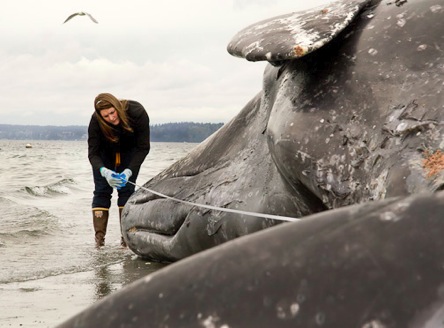
The whale is being towed to an undisclosed location where a necropsy (tentatively scheduled for Sunday) will be led by Cascadia Research and WDFW biologists. The body will be left to decompose over time and nourish the ecosystem. A local college will then recover the skeletal remains for educational purposes. View a photo gallery.
UPDATE: 4/20 NECROPSY RESULTS REVEALED
For the disturbing necropsy results on this gray whale, please click here.
Links of interest:
Seal Sitter founder and renowned nature writer Brenda Peterson co-authored (with native American Linda Hogan) the book, Sightings: The Gray Whale’s Mysterious Journey.
Seal Sitter scientific advisor, Dr. Toni Frohoff, is featured in a New York Times Magazine article about the gray whale birthing lagoons in Baja, Mexico.
SAD UPDATE: According to Cascadia Research, the gray whale seen feeding in West Seattle waters (not the whale discussed in the above post) on March 27th has been photographically matched to a 40 foot adult whale that died on April 11th near Fidalgo Island. Read the report here.
Related news:
Gray whales wash up in area waters (Vancouver Sun)
Otis Redding thanks his fans
Apr/15/10 08:21 AM
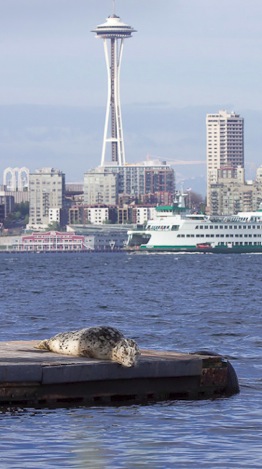
Otis returned to Elliott Bay about 6:20 this morning - hopefully, out looking for some breakfast! We will continue to keep you posted on his progress. NOAA’s stranding expert will be checking on him if he returns to the dock.
UPDATE (5:30 pm) After examining the dead gray whale on Arroyo Beach, Kristin Wilkinson of NOAA observed Otis late this morning and mid-afternoon. She says that while not able to fish optimally, he is drawing on his blubber layer - another reason he looks thin. Assuming he is not elderly or suffering from a compromised immune system, there is reason to believe that he may improve if allowed to rest in the sun undisturbed as he has been over the last few days. The fact that he is returning to the water and then back to rest is a very positive sign.
Otis Redding singin' the blues
Apr/12/10 01:29 PM
Sadly, after a three day absence, our spotted adult seal Otis is showing signs of distress (discharge from ear and mouth). He was extremely thin as well as he rested on the boat dock today. While he was quite alert, typically an adult seal would flee at the disruptions at the boat ramp this morning, including a private boat that made many repeated trips back and forth along his dock. This is a strong indication that he needs extra rest from having compromised health. Otis finally returned to the water around 11:40 when two very noisy Coast Guard security boats landed at the far ramp. Examination of his fecal material left on the dock showed evidence of parasites. NOAA and WDFW specialists have examined our photos and Seal Sitters is on alert for his return so that he can be closely monitored. Should you see Otis at the boatramp or elsewhere on shore, please call SS dispatch immediately @ 206-905-7325 (SEAL).
Svelte blonde lounges at boat dock
Apr/10/10 10:03 AM
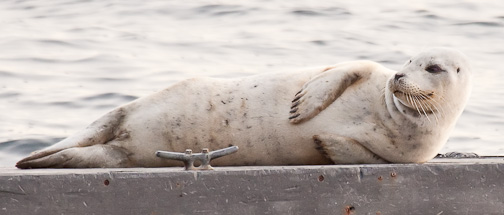
Trans-species morning
Apr/09/10 12:32 PM
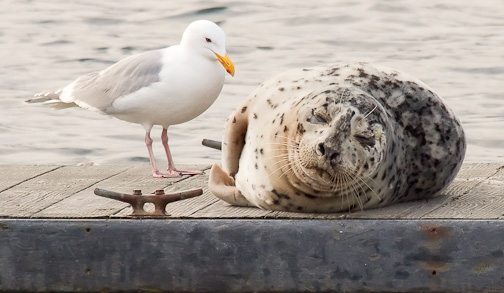
Should you see Otis over the next few days, make sure to let him relax and observe from a far distance. He appears to be quite healthy, but might have an ear infection. He’s very alert and adult harbor seals are quite shy and wary of people - and, therefore, easily scared back into the water. They need to gain strength and warm up just like seal pups!
Soulful seal on the dock of the bay
Apr/07/10 07:53 PM
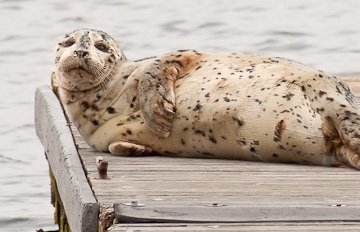
Netsilik Eskimos believed that while a seal’s body would perish, the seal’s soul was immortal. And, if treated with respect, the same seal would return in earthly form to be caught over and over again. (The Pinnipeds: Seals, Sea lions, and Walruses, Marianne Reidman. University of California Press)
Easter Seal (and friend)
Apr/04/10 10:04 AM
